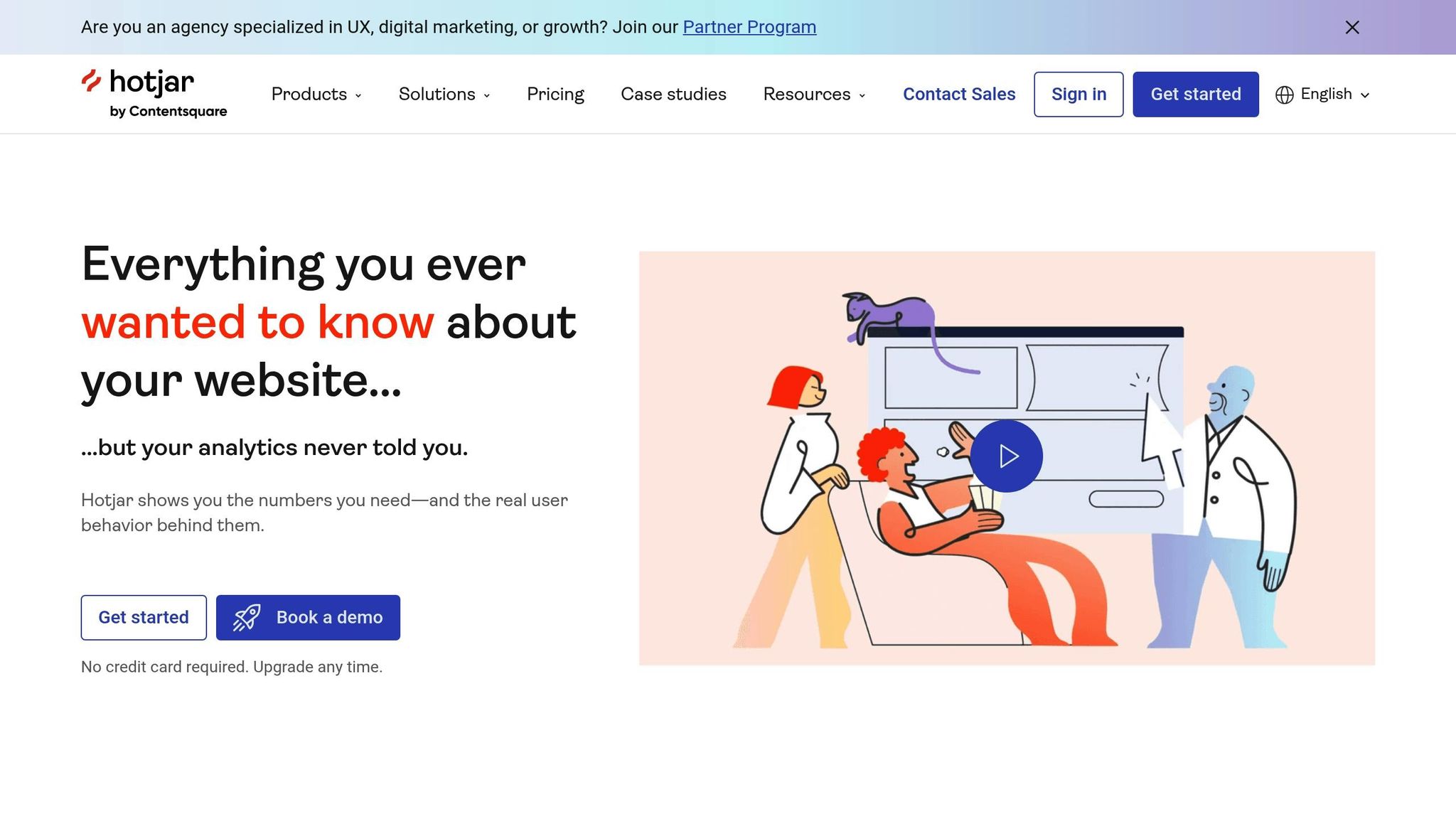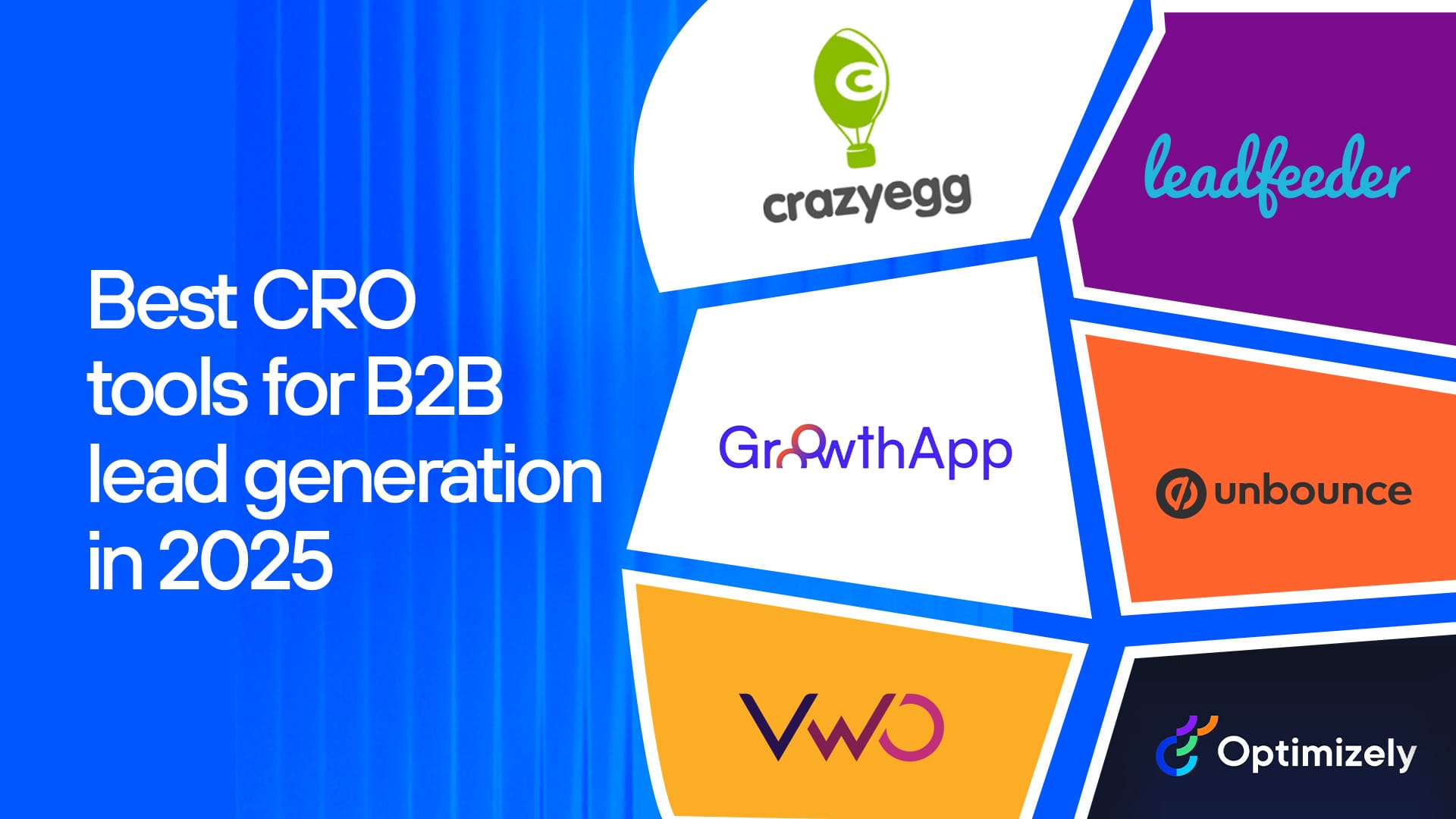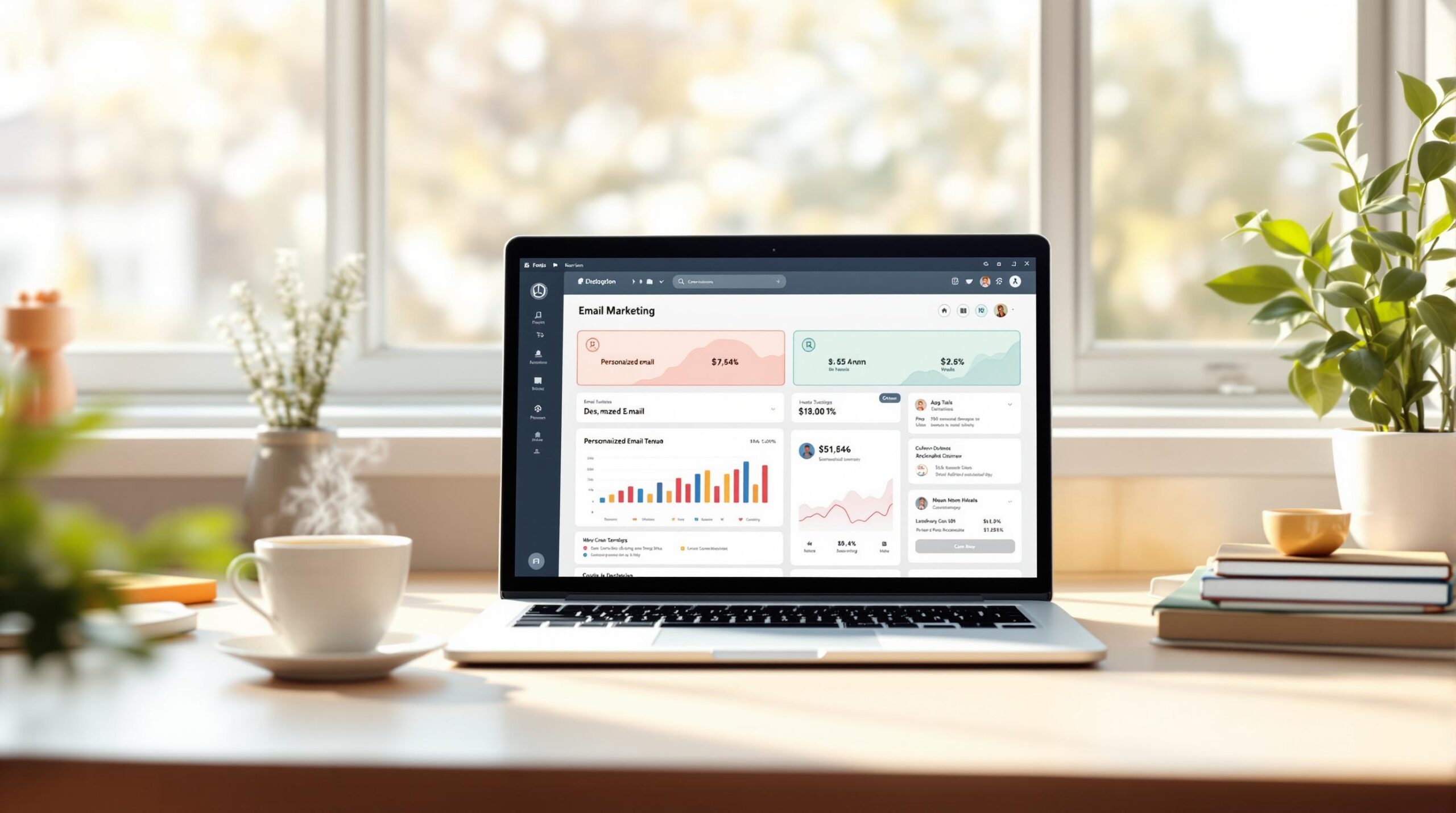Want to boost conversions and improve your website? Start by understanding how visitors behave on your site. Here’s what you need to know:
- Key Metrics to Track: Focus on traffic sources, engagement (bounce rate, time on page), and conversions (form submissions, purchases).
- Useful Tools: Use heatmaps, session recordings, analytics, and surveys to analyze user behavior.
- Segment Your Audience: Group visitors (e.g., trial users, at-risk users) based on actions and tailor your approach to each group.
- AI for Personalization: AI can predict visitor actions, automate A/B testing, and create custom experiences, boosting conversions by up to 20%.
- Quick Wins: Simplify navigation, speed up load times, and optimize for mobile to see immediate results.
Hotjar Tutorial: How To Analyse Your Website User Behaviour

Key Metrics and Tools for Analysis
To truly understand how visitors interact with your website, you need to focus on tracking the right metrics and using effective tools.
Website Metrics to Monitor
-
Traffic Sources and Demographics
Identify where your visitors are coming from and who they are to better align your content with their needs. -
Engagement Metrics
These reveal how users interact with your site:- Bounce rate
- Time spent on a page
- Pages viewed per session
- Navigation paths users follow
-
Conversion Metrics
Measure actions that indicate success:- Form submissions
- Email signups
- Purchase rates
- Percentage of returning customers
- Customer lifetime value
Tools to Analyze Visitor Behavior
The right tools can give you a clear picture of how users experience your site. Here’s a breakdown:
| Tool Type | Primary Use | Key Benefits |
|---|---|---|
| Heatmaps | Tracks visual behavior | Highlights where users click, scroll, and focus attention |
| Session Recording | Analyzes visitor journeys | Reveals real interactions and problem areas |
| Analytics | Provides quantitative data | Tracks traffic, conversions, and user flow |
| Surveys | Gathers user feedback | Offers direct insights into user experiences |
Ensuring Privacy and Data Accuracy
To maintain trust and gather reliable data, follow privacy regulations like GDPR and CCPA. Set up tracking parameters carefully to ensure your data is clean and actionable.
Integration Tips for Tools
When selecting tools, prioritize those that:
- Work well with your current systems
- Are easy to use
- Offer customizable reports
- Scale with your needs
- Comply with privacy standards
With the right metrics and tools in place, you’ll be ready to turn data into meaningful improvements.
Converting Data into Actions
Use your data to make meaningful changes that drive results.
Creating Visitor Groups
Divide your visitors into groups based on their behavior to address their specific needs effectively.
| Segment Type | Key Behaviors | Action Items |
|---|---|---|
| Anonymous Leads | Site visits, content views | Improve landing pages, develop tailored content |
| Trial Users | Product testing, feature use | Refine onboarding, showcase essential features |
| Active Users | Frequent engagement, core usage | Boost retention, introduce advanced options |
| At-Risk Users | Reduced activity, fewer logins | Run re-engagement campaigns, offer personalized support |
"Behavioral segmentation is about understanding customers not by who they are, but by what they do, using insights derived from customers’ actions." – Jan Teichmann
Once you’ve segmented your audience, analyze these groups to identify and address conversion challenges.
Finding and Fixing Problems
Pinpoint conversion barriers using both numbers and user feedback:
-
Track Every Step
MathElf found a 20% drop in signups caused by a confusing referral code field. After removing it, their signup rates increased by 20%. -
Optimize for Mobile
Rev noticed mobile users abandoning their transcription landing page. By simplifying the mobile experience and speeding up the page, they boosted conversions by 20%. -
Simplify Navigation
Temi observed users struggling with complex navigation in session recordings. By reorganizing content and putting key details above the fold, trial submissions jumped by 33%.
Choosing What to Fix First
Focus on changes that offer the most benefit with the least effort:
-
Quick Wins
- Speed up page load times
- Simplify form fields
- Make call-to-actions clear and visible
-
Data-Driven Issues
- Address pages with high exit rates
- Fix steps where users drop off
- Improve underused features
-
Customer Feedback
- Act on feedback from chat tools
- Solve common support issues
- Use insights from user testing
Rev applied this approach by adding live chat to their landing pages and incorporating customer suggestions into their content. This customer-focused strategy resulted in a 60% increase in landing page conversions.
sbb-itb-22854bb
AI Tools for Better Conversions
Predicting Visitor Actions
AI can track and analyze visitor behavior in real-time, spotting patterns that indicate when someone might leave or make a purchase. For instance, Happy Mammoth used AI to predict these behaviors and managed to recover 30% more abandoned carts automatically. Growth Marketer Martin Kovachev shared:
"We took a break from spending thousands of dollars in ads and redesigning our website, plugged Growie into our website instead, and in 2 months, we went from 0 leads to 50 sign ups"
AI-Powered Testing
AI also simplifies and speeds up testing processes. Traditional A/B testing often takes months to produce actionable insights, but AI can test multiple variables simultaneously and apply the best-performing options automatically. For example, Sunshine.co.uk found that showing lower prices unintentionally reduced trust. By adding a money-back guarantee to address concerns about quality, they secured a $14 million budget increase.
Custom Content for Each Visitor
AI takes personalization to the next level by turning static websites into dynamic experiences. It doesn’t just rely on basic demographic data but adjusts based on real-time user behavior. Shudofsky Coaching saw how effective this approach could be when they doubled their lead conversions without increasing ad spend. Founder Melanie Shudofsky explained:
"It’s easy to think you need more traffic to make more money for your company. GrowthApp shows us we only need to work smarter. I think the best part is we didn’t need to do it ourselves"
Here are some real-world results from businesses using AI-driven personalization:
| Business Type | Personalization Focus | Result |
|---|---|---|
| SaaS | User onboarding | 42% signup increase |
| E-commerce | Cart recovery | 30% fewer abandoned carts |
| Consulting | Lead generation | Double conversion rate |
| General | Overall optimization | 3.2x checkout conversion |
On average, companies leveraging AI personalization see a 20% boost in conversion rates.
Making Changes That Last
Better Website Experience
Use visitor data to make impactful, lasting updates to your website. The ICE framework – Impact, Confidence, Ease – is a simple way to decide which changes to tackle first.
Take Temi as an example. They studied how visitors interacted with their site and made specific changes to their landing page. By simplifying navigation and moving key content above the fold, they boosted trial submissions by 33%.
Here’s how some companies have improved their websites:
| Focus Area | Impact Level | What They Did | Result |
|---|---|---|---|
| Form Optimization | High | MathElf removed unnecessary fields | 20% more completions |
| Mobile Experience | High | Rev adjusted their desktop site for mobile | 20% fewer drop-offs |
| Navigation | Critical | Temi streamlined their menu | 33% increase in trials |
| Customer Support | High | Rev added Intercom chat | 60% boost in landing page conversions |
To maintain these results, ongoing monitoring and adjustments are essential.
Track and Improve Results
Once your website is optimized, the key to lasting growth is tracking and refining your updates. A strong tracking system ensures every change is measured for effectiveness. Companies that combine traditional analytics with AI tools can quickly identify new opportunities.
Here’s how to keep improving:
-
Monitor Core Metrics
Keep an eye on important metrics like pageviews, time spent on pages, bounce rates, and conversion points. Track how users move through your site and where they drop off. -
Validate Changes
Test updates with a smaller audience before rolling them out widely. For instance, Rev.com removed their sub-navigation without testing first and saw a 10% drop in conversions. Testing helps avoid these kinds of setbacks.
A good example of systematic improvement comes from an e-commerce site that analyzed their Site Content reports. They found that adding detailed product descriptions and high-quality images significantly reduced bounce rates. Rolling out these changes consistently created a better shopping experience.
Conclusion
This guide has outlined how using targeted analysis and AI-driven insights can improve conversion rates. By understanding visitor behavior and applying reliable tools and metrics, you can achieve up to a 223% return on investment (ROI).
Here’s how to turn raw data into actionable insights in three key phases:
| Phase | Key Steps | Impact |
|---|---|---|
| Data Collection | Track key metrics, use behavior analysis tools | Lays the groundwork for all improvements |
| Analysis & Testing | Study behavior patterns, test and validate changes | Boosts conversions by 10-15% through personalization |
| Implementation | Apply tested changes and monitor results | Improves specific metrics by up to 60% |
These steps create a straightforward plan for optimizing your website. Success comes from combining hard data with a deeper understanding of user behavior. As Alexandre Airvault explains:
"To truly harness the power of behavior data, start by regularly reviewing your Google Analytics reports and identifying key trends and opportunities. Implement changes based on these insights, and continuously monitor the impact of your optimizations".
To stay on track, focus on these essentials:
- Ongoing Monitoring: Regularly track key metrics to spot new opportunities.
- Targeted Testing: Test changes on smaller groups before rolling them out broadly.
- AI Tools: Use AI to uncover deeper insights and automate optimizations, which can deliver up to 4x higher conversion rates.
Improving conversions requires knowing what users do and why they do it. As Barron Caster points out:
"Learning tools are important as they answer key questions: the ‘what’ and ‘how’ of user behavior".



